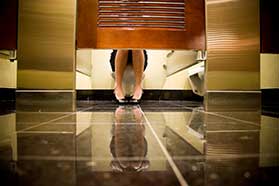Urge Incontinence Treatment in Los Angeles, CA

Urge incontinence - otherwise known as overactive bladder or spastic bladder—is a condition that causes an involuntary loss of urine . If you suffer from urge incontinence, leakage typically occurs when you have a strong, sudden need to urinate. The urge can happen suddenly and at any time, regardless of the amount of urine in the bladder. These urges cause urine to leak out of the bladder unexpectedly.
Urinary incontinence can range from mild, occasional leaking to chronic uncontrolled urination. Incontinence itself is not a disease; it is usually a symptom of an underlying medical condition, like urinary tract infections, vaginal infections or constipation. In this case, urge incontinence is usually temporary, although it can be chronic if left untreated.
Causes of Urge Incontinence
The urgent and frequent need to pass urine is usually caused by a problem with the muscles in the walls of the bladder. At the root of urge incontinence is the detrusor muscles, which relax to allow the bladder to fill with urine and then contract when you finish urinating. If you have urge incontinence, the detrusor muscles contract too often, creating an urgent need to urinate.
The reason a person's detrusor muscles contract too often may not always be clear, but possible causes include:
- Drinking too much alcohol or caffeine
- Nerve damage
- Urinary tract infections
- Weakened pelvic floor muscles
- Neurological conditions
In most cases, we don't know why urge incontinence develops. In such cases, the condition is called overactive bladder syndrome . Symptoms may get worse at times of stress or after drinking caffeinated drinks. Some women develop urge incontinence after menopause because a drop in estrogen can cause the lining of the vagina to shrink.
Diagnosis of Urge Incontinence
For some people, urge incontinence is just an inconvenience that does not require medical treatment. However, if it impedes your daily activities, you may want to visit your doctor to discuss treatment options. To diagnose urge incontinence, your doctor will ask about your medical history and perform a physical exam . He or she may also order a bladder stress test or urinalysis testing.
Your physician may recommend further urodynamic testing if surgery is an option or if other treatments have failed. This series of tests provides a more advanced way to check bladder function. The actual tests a physician performs during urodynamic testing often vary, but, in general, urodynamic testing includes the following:
- Cytometry: Tests that measure bladder pressure at different levels of fullness.
- Postvoid residual (PVR) measurements: This test measures the amount of urine that stays in your bladder after urination.
- X-rays or ultrasound: Your physician may order imaging tests to examine changes in the position of the bladder and urethra during urination, coughing or straining.
Treatment of Urge Incontinence
Urinary incontinence is not something that occurs normally with age. Most people who suffer from persistent urge incontinence turn to their doctors for treatment. The best treatment depends on the cause of your incontinence, but treatment of urge incontinence generally includes the following:
- Behavioral training: Several types of behavioral methods can treat urinary incontinence: bladder training, habit forming, biofeedback and pelvic muscle exercises.
- Lifestyle changes: Losing weight or avoiding certain triggers often helps to reduce or stop urge incontinence leakage.
- Medications: Doctor-prescribed medications are often combined with other treatments to help reduce symptoms. These medicines work by blocking certain nerve impulses to the bladder, which relax the bladder muscle.
- Non-surgical procedures: Your healthcare provider may recommend electrical stimulation, which sends a mild electrical current to the pelvic muscle, or platelet-rich plasma (PRP) injections, which stimulate tissue rejuvenation.
- Medical devices: Your physician can insert a plastic device to help control urine flow.
- Surgery: There are several different surgeries available to correct urge incontinence. The goal of surgery is to lift the urethra, the bladder or both into their normal positions.
Request more information about urge incontinence today. Call (424) 365-1800 or contact Dr. Jeremy Fischer online.
Vitality Integrative Medicine
Address
4849 Van Nuys BlvdSuite 104
Sherman Oaks, CA 91403
(424) 365-1800
www.vitalityintegrative.com
Hours
Mon:
8:00 am - 6:00 pm
Tue:
8:00 am - 6:00 pm
Wed:
8:00 am - 6:00 pm
Thu:
8:00 am - 6:00 pm
Fri:
8:00 am - 6:00 pm
Sat:
8:00 am - 12:00 pm

